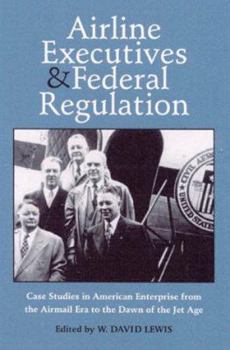Airline Executives Federal Regulation: Case Studies in American Enterprise from
(Part of the Historical Perspectives on Business Enterprise Series)
This book is a collection of eight case studies of relationships between airline executives and federal regulatory agencies from the passage of the Air Commerce Act in 1926 to the Airline Deregulation... This description may be from another edition of this product.
Format:Hardcover
Language:English
ISBN:0814208339
ISBN13:9780814208335
Release Date:March 2000
Publisher:Ohio State University Press
Length:288 Pages
Weight:1.55 lbs.
Dimensions:1.1" x 6.3" x 9.2"
Customer Reviews
2 ratings
Airline executives and their relationship with the government
Published by Thriftbooks.com User , 17 years ago
This is a book about airline executives and their relationship with the government. Some embraced regulation, others abhorred it. This is a case study which highlights the benefits and failures of government in the growth of commercial aviation. The leaders are individuals of strong egos, character and vision. They are the subject of this book and the author has selected executives of representative airlines based on size, scheduled or unscheduled, and manner of dealing with federal regulators. Case studies are focused on the forty year period after 1938. To begin Lewis, in his introductory statement presents a conventional summary of events leading up to the Air Commerce Act of 1926, except that he includes some information on individuals whose careers were ruined by Walter Folger Brown's vision of federal regulation. For example Harris M. Hanshue, of Western Air Express (WAE), succumbed to Brown's desire for a central transcontinental air route. WAE was a highly successively line but did not fly east of the Mississippi River. Executives who were resilient in the face of this kind of oversight, hardship, and ruin are the heroes. This is a book of their strategies in dealing with the regulatory environment. The reader is left with a better understanding of the workings of government in the aviation business. Briefly summarized are the individuals and the airlines highlighted. George R. Hann was the President of Pittsburgh Aviation Industries Corporation (PAIC), parent of Pennsylvania Air Lines. PAIC was incorporated on November 15, 1928. An aviation promoter, Hann agreed with Postmaster General Brown that a large well funded company could operate better that many unruly smaller ones. The "shotgun wedding" merged Transcontinental Air Transport (TAT) and Western Air Express to create Brown's central transcontinental route. By manipulating the regulatory system, Hann insured PAIC's gain. Despite his abilities, politics intruded when, as a result of the fallout from the "spoils conference," Airlines were forced to change their names in order to be eligible to rebid on new temporary mail contracts. Hann was forced to give up his position as president because the new company could not include former executives. Hann's approach to federal regulation was characterized by his willingness to link his business to government policy. C. R Smith's American Airlines thrived under government regulation. American's success is a testament to his legacy. Smith did not totally embrace federal regulation but he understood the reality of the situation and worked within the system to gain whatever advantage was possible. A native Texan, Smith maintained connections to the top people in the Democratic party and influential Texans. In 1934 he was appointed president of the reorganized American Airlines. He saw "the airline industry as a business in concert with a federal presence as it evolved within national and international environments."(84) On the one
Interesting Study of the Airline Industry
Published by Thriftbooks.com User , 20 years ago
Okay, for starters, you probably do not want to read this book unless (a) you are fascinated by the airline industry (as I am) or (b) you are trying to impress some professor or teacher. Believe me, if you're the latter, you could write a really great paper based on this book.The book is a collection of eight case studies by various authors, each examining the relationship between various airline executives and the federal government during the period of time the government heavily regulated the airline industry (roughly 1926 to 1978). In all likelihood, sufficient time has passed for most people to have forgotten what airlines were like in the time of federal regulation. Some have even called for a reinstituion of regulation,but unlike W. David Lewis, the editor fo the book, I do not believe the government will ever attempt regulation again. If it were going to do so, it probably would have done so in the wake of the 9/11 crisis and its affect on the airlines.The book does an excellent job of covering various types of airlines and their relationships with the government, with a focus on executives from the various airlines.The executives profiled are among some of the most prominent characters to have passed through the industry, and this is an industry that has had more than its fair share of characters. Some had adversarial relationships with the government during the time of federal regualtion; others thrived in the regulated environment. Interestingly, some of th airlines documented and featured no longer exist. Eastern Airlines, for example, was an airline that ultimately failed once dereguation took place, although its doom may have been more the fault of its chief executive at the time and his adversarial relationships with his labor unions (for more on this, see the book "Hard Landing").The book itself does not draw any final conclusions, leaving any ultimate conclusion to the reader. I would love to see a follow-up, with a further examination of other airline executives and their relationships with the government both during and after federal regulation.A great scholarly work, but definitely not for the casual reader.





